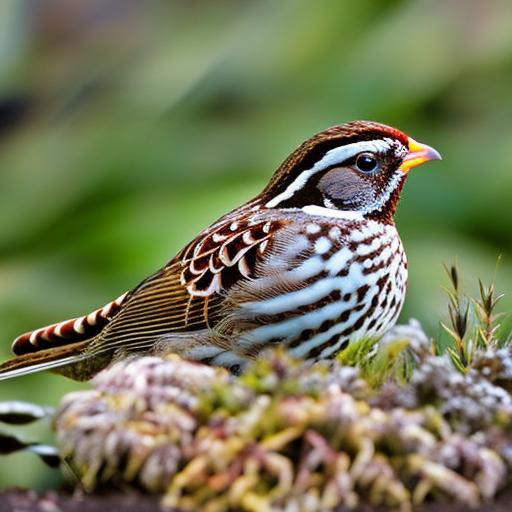Keeping quail in a greenhouse offers a multitude of benefits for both the quail and the greenhouse owner. Firstly, the controlled environment of a greenhouse provides a stable and comfortable habitat for quail, allowing them to thrive and produce high-quality eggs and meat. The greenhouse also offers protection from predators and adverse weather conditions, ensuring the safety and well-being of the quail. Additionally, the greenhouse environment allows for easy monitoring and management of the quail, making it convenient for the owner to care for the birds and maintain their health.
Furthermore, keeping quail in a greenhouse can contribute to sustainable and eco-friendly practices. The waste produced by the quail can be used as fertilizer for the plants in the greenhouse, creating a closed-loop system that minimizes waste and maximizes efficiency. This not only benefits the plants in the greenhouse but also reduces the environmental impact of quail farming. Additionally, the greenhouse can serve as a source of fresh produce for the quail, providing them with a diverse and nutritious diet. Overall, keeping quail in a greenhouse offers a range of benefits for both the quail and the environment, making it an attractive option for poultry farming.
Key Takeaways
- Quail in a greenhouse can help control pests and provide natural fertilizer for plants
- Provide proper ventilation, bedding, and perches for quail to thrive in a greenhouse
- Consider breeds like Coturnix and Bobwhite for their adaptability to greenhouse environments
- Offer a balanced diet of commercial feed, greens, and clean water to quail in a greenhouse
- Regularly monitor temperature, humidity, and cleanliness to ensure the health and well-being of quail in a greenhouse
- Use heaters, fans, and misters to regulate temperature and humidity for quail in a greenhouse
- Harvest quail eggs and meat for a sustainable source of protein from a greenhouse environment
Setting Up the Ideal Quail Habitat in a Greenhouse
Creating the ideal habitat for quail in a greenhouse involves careful planning and consideration of their specific needs. Firstly, it is important to provide ample space for the quail to move around and exhibit natural behaviors. This can be achieved by setting up spacious pens or enclosures within the greenhouse, allowing the quail to roam freely while still being protected from external threats. Additionally, providing suitable nesting areas and materials is essential for ensuring the comfort and well-being of the quail, as it allows them to lay eggs in a safe and secure environment.
Furthermore, it is crucial to maintain proper ventilation and air circulation within the greenhouse to prevent the buildup of ammonia and other harmful gases. This can be achieved through the use of fans, vents, and windows to ensure that the air quality remains high and conducive to the health of the quail. In addition, providing adequate lighting is important for regulating the quail’s reproductive cycles and promoting healthy growth and development. By creating a well-designed and carefully managed habitat, quail can thrive in a greenhouse environment, leading to increased productivity and overall well-being.
Choosing the Right Quail Breeds for Greenhouse Living
When selecting quail breeds for greenhouse living, it is important to consider their adaptability to indoor environments and their suitability for egg and meat production. One popular choice for greenhouse quail farming is the Coturnix quail, also known as Japanese quail, which is prized for its prolific egg-laying capabilities and fast growth rate. This breed is well-suited to living in confined spaces and can thrive in greenhouse conditions with proper care and management.
Another option to consider is the Bobwhite quail, which is known for its flavorful meat and adaptability to various environments. While Bobwhite quail may require more space compared to Coturnix quail, they can still be successfully raised in a greenhouse with adequate room and proper environmental control. Additionally, other breeds such as the California quail or Gambel’s quail may also be suitable for greenhouse living, depending on the specific goals and preferences of the greenhouse owner.
Ultimately, the choice of quail breed should align with the intended purpose of raising quail in the greenhouse, whether it be for egg production, meat production, or both. By selecting the right breed for greenhouse living, owners can maximize the productivity and success of their quail farming endeavors.
Feeding and Watering Quail in a Greenhouse
Feeding and watering quail in a greenhouse requires careful attention to their dietary needs and access to clean water at all times. Quail are omnivorous birds that require a balanced diet consisting of high-quality feed, fresh greens, and protein sources such as insects or mealworms. In a greenhouse environment, it is important to provide access to a variety of nutritious foods to ensure that the quail receive essential nutrients for optimal health and productivity.
Additionally, ensuring access to clean water is crucial for maintaining the well-being of quail in a greenhouse. Water should be provided in shallow containers or specialized waterers that are easily accessible to the quail while preventing spillage and contamination. Regularly monitoring water quality and cleanliness is essential to prevent dehydration and maintain overall health.
Furthermore, it is important to consider the impact of feeding and watering practices on the greenhouse environment. Minimizing food waste and implementing sustainable feeding practices can help reduce environmental impact while promoting efficient resource utilization. By carefully managing feeding and watering practices, greenhouse owners can ensure that their quail receive proper nutrition while minimizing waste and environmental impact.
Maintaining the Health and Well-being of Quail in a Greenhouse
Maintaining the health and well-being of quail in a greenhouse involves proactive management practices to prevent disease, promote good hygiene, and monitor overall bird health. Regular observation of quail behavior, appearance, and egg production can provide valuable insights into their well-being and alert owners to any potential issues that may arise. Additionally, implementing biosecurity measures such as controlling access to the greenhouse and practicing good sanitation can help prevent the spread of diseases among the quail population.
Furthermore, providing regular veterinary care and vaccinations can help safeguard the health of quail in a greenhouse environment. Working with a qualified avian veterinarian can provide valuable guidance on disease prevention, treatment options, and overall health management practices. Additionally, implementing a quarantine protocol for new birds or those returning from shows or exhibitions can help prevent the introduction of diseases into the greenhouse environment.
In addition to disease prevention, maintaining good hygiene practices within the greenhouse is essential for promoting overall bird health. Regular cleaning of pens, nesting areas, feeders, and waterers can help prevent the buildup of harmful bacteria and parasites that can negatively impact quail health. By prioritizing proactive health management practices, greenhouse owners can ensure that their quail remain healthy and productive.
Managing Temperature and Humidity for Quail in a Greenhouse

Managing temperature and humidity levels within a greenhouse is crucial for ensuring the comfort and well-being of quail. Quail are sensitive to extreme temperatures and high humidity levels, which can negatively impact their health and productivity. Therefore, it is important to implement effective climate control measures to maintain optimal conditions for quail living in a greenhouse environment.
During hot weather, providing adequate ventilation, shade, and access to cool water can help prevent heat stress in quail. Additionally, installing fans or misting systems can help lower temperatures within the greenhouse and create a more comfortable environment for the birds. Conversely, during cold weather, providing supplemental heat sources such as heat lamps or radiant heaters can help maintain appropriate temperatures within the greenhouse.
In addition to temperature management, controlling humidity levels is also important for maintaining optimal conditions for quail. High humidity can create an environment conducive to mold growth and respiratory issues in quail, while low humidity can lead to dehydration and respiratory problems. Monitoring humidity levels with hygrometers and implementing measures such as ventilation or humidifiers can help maintain appropriate humidity levels within the greenhouse.
Overall, effective management of temperature and humidity within a greenhouse is essential for ensuring the comfort, health, and productivity of quail. By implementing climate control measures tailored to the specific needs of quail, greenhouse owners can create an environment that supports optimal bird welfare.
Harvesting Quail Eggs and Meat from a Greenhouse Environment
Harvesting quail eggs and meat from a greenhouse environment requires careful planning and consideration of food safety practices. When collecting eggs from quail in a greenhouse, it is important to handle them with care to prevent breakage or contamination. Storing eggs in clean, cool conditions can help maintain their quality and freshness until they are ready for consumption or sale.
Additionally, harvesting meat from quail raised in a greenhouse involves humane processing practices that prioritize bird welfare and food safety. Implementing proper slaughter techniques and sanitation measures is essential for ensuring that meat products are safe for consumption. Following established guidelines for processing poultry products can help minimize food safety risks while maintaining high standards of quality.
Furthermore, maintaining records of egg production and meat harvests can provide valuable insights into the productivity of quail in a greenhouse environment. Tracking production levels, egg quality, and meat yields can inform future management decisions and help optimize overall farm performance.
In conclusion, harvesting eggs and meat from quail raised in a greenhouse environment requires attention to detail, adherence to food safety practices, and a commitment to humane treatment of birds. By prioritizing these considerations, greenhouse owners can ensure that their quail products are safe, high-quality, and ethically produced.
If you’re considering keeping quail in a greenhouse, you may also be interested in learning about the best practices for setting up a chicken coop. Poultry Wizard offers a helpful article on chicken coop nest box that provides valuable insights into creating a comfortable and functional space for your poultry. Understanding the principles of coop design and maintenance can be beneficial when planning the layout and structure of your quail habitat within a greenhouse.
FAQs
What are the benefits of keeping quail in a greenhouse?
Quail can thrive in a greenhouse environment due to the controlled temperature, protection from predators, and access to natural sunlight. Greenhouses also provide a suitable space for quail to forage and roam freely.
What should be considered when setting up a greenhouse for quail?
When setting up a greenhouse for quail, it is important to ensure proper ventilation, adequate space for the quail to move around, and access to clean water and food. Additionally, the greenhouse should be predator-proof to protect the quail.
What type of housing is suitable for quail in a greenhouse?
Quail can be housed in various types of enclosures within a greenhouse, such as wire cages, aviaries, or pens with appropriate bedding material. The housing should provide enough space for the quail to move around and engage in natural behaviors.
What do quail eat and how can they be fed in a greenhouse?
Quail are omnivorous and can be fed a diet of commercial quail feed, supplemented with fresh greens, insects, and grit. In a greenhouse, feeders can be placed in a designated area to provide easy access for the quail.
How can the greenhouse environment be maintained for quail health?
Maintaining a clean and hygienic environment is crucial for quail health in a greenhouse. This includes regular cleaning of the enclosure, providing fresh water, and monitoring the temperature and humidity levels to ensure they are within the optimal range for quail.
What are some common challenges when keeping quail in a greenhouse?
Common challenges when keeping quail in a greenhouse include managing the temperature and humidity levels, preventing disease outbreaks, and protecting the quail from predators. It is important to address these challenges to ensure the well-being of the quail.
Meet Walter, the feathered-friend fanatic of Florida! Nestled in the sunshine state, Walter struts through life with his feathered companions, clucking his way to happiness. With a coop that’s fancier than a five-star hotel, he’s the Don Juan of the chicken world. When he’s not teaching his hens to do the cha-cha, you’ll find him in a heated debate with his prized rooster, Sir Clucks-a-Lot. Walter’s poultry passion is no yolk; he’s the sunny-side-up guy you never knew you needed in your flock of friends!







